sierraclub.org - sierra magazine - november/december 2009 - solving the climate puzzle


Solving the Climate Puzzle: One Piece at a Time
By Paul Rauber
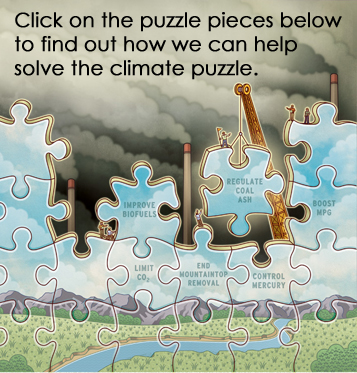 Like the poor schlub in the latest sci-fi blockbuster, you're suddenly called upon to save the planet, racing against time to stop the looming apocalyptic fireball from frying all the penguins and pandas and redwoods, not to mention your adorable sweetheart. You have no choice--you've gotta do it. As author and 350.org founder Bill McKibben says, addressing global climate change is simply "the biggest problem humans have ever faced."
Like the poor schlub in the latest sci-fi blockbuster, you're suddenly called upon to save the planet, racing against time to stop the looming apocalyptic fireball from frying all the penguins and pandas and redwoods, not to mention your adorable sweetheart. You have no choice--you've gotta do it. As author and 350.org founder Bill McKibben says, addressing global climate change is simply "the biggest problem humans have ever faced."
Why so big? Because it requires us to find a new standard operating procedure. Until now, humanity prospered by burning stuff--to eat, stay warm, get around, and power our iPhones. Sadly, all that burning is radically changing the climate. Last time there was this much carbon dioxide in the air, giant six-horned rhinos and proto-whales roamed the planet.
And not only do we have to save the world; we have to do so in a hurry. (Cut to that apocalyptic fireball hurtling toward Earth.) We might have made a good start under President Al Gore in 2001, but instead we wasted eight of the nine hottest years in recorded history driving Hummers, invading Iraq, and drill-baby-drilling. Time is short if we want to avoid a future that looks like an outtake from The Road.
Happily, U.S. voters finally got things going by electing Barack Obama. Rather than contenting himself with tackling healthcare reform, two wars, and the worst economic downturn since the Great Depression, Obama has made climate change a priority. And he's not waiting around for Congress to act first: His executive-branch agencies are already shifting us toward a clean-energy future. Some of these actions are big and straightforward--boosting automotive miles-per-gallon requirements, for example--while others are arcane and wonky, like sorting out the life cycle emissions for various kinds of biofuels. All are pieces needed to complete the puzzle that will give us back our cool, verdant planet.
But Washington, D.C., is built for stasis. Politicians and bureaucrats prefer the path of least resistance, which is to do nothing--or, failing that, to do as little as possible. For major change, you need overwhelming popular support. That's why the Sierra Club started its Big Picture Campaign, to rally support for all the jigsaw pieces, large and small, that together will solve the climate puzzle and save our bacon in the final reel.
CO2: Smack Polluters With the Clean Air Act
 Who Else Is in Danger?
Who Else Is in Danger?
Humans are not the only creatures endangered by global warming. The creatures pictured above will be among the first to feel its effects. Go to sierraclub.org/endangered for details.
When future historians consider George W. Bush, their harshest criticism may well target his eight long years of inaction on global warming. During that time, U.S. emissions of greenhouse gases increased precipitously, making the current task of stabilizing the climate correspondingly more difficult.
Pre-Bush, the EPA was on its way to regulating carbon dioxide as a pollutant under the Clean Air Act, which plainly says that the agency "shall regulate" any air pollutant "reasonably anticipated" to endanger "public health or welfare," the latter including effects on "climate or weather." Since nearly all of the world's climate scientists agree that carbon dioxide causes global warming, it looked like an open-and-shut case. So in 1999 the Sierra Club and other groups petitioned the EPA to follow up and regulate CO2.
Enter Bush. Only two months after taking office, he reneged on his campaign pledge to treat carbon dioxide as a pollutant. His EPA, after ignoring the Sierra Club's petition, opined in 2002 that the Clean Air Act didn't mean what it said, and that even if it did, it would be "bad policy" for the agency to regulate greenhouse gases.
What followed was a dizzying legal battle that might as well have been called Sierra Club v. Humpty Dumpty. ("When I use a word," the doomed egg told Alice in Through the Looking Glass, "it means just what I choose it to mean--neither more nor less.") The Club, several states, and others challenged the EPA reversal. The issue worked its way up the courts, and in 2006 the U.S. Supreme Court agreed to take the case. In April 2007 a 5-to-4 majority of the high court sided with the Sierra Club. "It's unfortunate, but not surprising, that it took a Supreme Court case to clarify the meaning of words such as 'pollutant,' 'endanger,' 'weather,' and 'climate' for the Bush administration," Sierra Club senior attorney David Bookbinder said.
Bush's obstructionism didn't end there. Rather than regulate CO2 as the Supreme Court directed, EPA administrator Stephen Johnson opened a brand-new period of public comment on the issue. A year passed from the court's decision, and still the EPA took no action. This January, Bush left office with his do-nothing record intact.
What a difference an election makes. In April the Obama administration's EPA proposed an "endangerment finding," a declaration that greenhouse gases contribute to air pollution and may put public health and welfare at risk. Once formally adopted, the finding will oblige the EPA to regulate CO2 and other greenhouse gases. Obama has made it clear that he would prefer that Congress take the lead, but should it fail, the EPA has not only the authority but also the responsibility to act.
WHAT YOU CAN DO
During the public comment period, the Big Picture Campaign organized more than 41,000 endorsements of the EPA's endangerment finding and turned out thousands of supporters at public hearings across the country. To become a Big Picture activist, mail in the postcard on page 50 or go to
sierraclub.org/bppetition.
MPG: Build Better Cars

Hollywood's not waiting for new fuel-efficiency standards. Many marquee names are already driving green wheels. Brad Pitt drives a Hydrogen 7; Cameron Diaz and Tom Hanks favor Priuses with solar panels; George Clooney rides a two-seater electric Tango; Leonardo DiCaprio gets behind the wheel of a Tesla Roadster; and Ed Begley tops them all with his bike.
When you're trying to stop a planetary-scale process like climate change, you don't need to sweat the cow farts and hair spray. One of the largest contributors to global warming is parked in your driveway: Passenger vehicles account for 20-plus percent of the nation's greenhouse gases.
On a personal level, we can do a lot to reduce that burden. We can properly inflate our tires, stop hauling around heavy junk, carpool, or hop on a bike instead. But only a limited number of people are willing to transform their driving habits; cutting emissions would be a lot easier if cars simply got better mileage. In fact, the biggest single step the United States can take to curb global warming is to make all new cars and trucks go farther on a gallon of gas.
For more than three decades, the Sierra Club lobbied Congress, Detroit, the White House, the states, and anyone who would listen to require auto manufacturers to build fuel-efficient cars. Having tied its future to gas-guzzling SUVs and light trucks, Detroit won the battle--fuel-economy standards for passenger cars remained stuck at 27.5 mpg for 20 years--but lost the war, ceding the market in efficient cars to Japan and Korea at a time when demand for monster SUVs was collapsing.
Frustrated by Congress's refusal to toughen fuel-efficiency standards, California and 14 other states tried to adopt their own rules for new vehicles--but were blocked by the Bush administration. That changed with the election of Obama, who announced in May that his administration would require new vehicles to achieve 35.5 mpg by 2016 instead of 2020. This rule, which the EPA officially announced this September, is predicted to yield greenhouse-gas savings equivalent to taking 177 million cars off the road each year.
WHAT YOU CAN DO
After Obama boosted fuel-economy standards, almost 16,000 Big Picture supporters wrote to thank him. In September the EPA and the National Highway Traffic Safety Administration issued the final rules. You can add your comments in favor of better cars to the public record at
action.sierraclub.org/bigpicture_cleancars.
Mountaintop Removal: End This Ugly Way to Dig Up Filthy Fuel
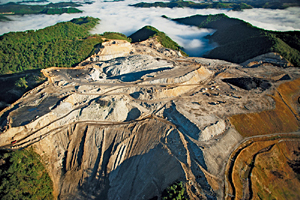 Another mountain gone in Logan County, West Virginia.
Another mountain gone in Logan County, West Virginia.
The damage from mountaintop-removal mining, it seems, isn't limited to blasted peaks and buried hollows. The Gallup-Healthways U.S. Well-Being Index surveyed the country and found that the deeply scarred coalfields of West Virginia and Kentucky are not only the poorest parts of the United States but also the saddest.
The unhappiest corner of all is Kentucky's Fifth Congressional District. It ranks 435th out of 435 districts nationwide in physical health, emotional health, and general "life evaluation." Its poverty rate is twice the national average. And it contains all of Kentucky's 14 active mountaintop-removal coal mines.
Unlike the bold administrative actions in other pieces of the Big Picture Campaign, the Obama White House is not leading the way in ending mountaintop removal. But there have been several small steps: In April, responding to a legal challenge by the Sierra Club and other groups, the Interior Department tried to make it harder to dump mining waste near streams. (The move was later blocked in court.) In July the EPA determined that all 79 mountaintop-removal permits then under review would likely violate the Clean Water Act. And in September the Army Corps of Engineers proposed eliminating its streamlined permit process for surface mining.
None of this, however, will stop mountaintop removal. What's needed is simply for regulatory agencies to follow the clear intent of the Clean Water Act, which strictly limits the dumping of fill into streams, allowing it, for example, in the course of building a new highway. In 2002 the Bush administration expanded the definition of "fill" to include the waste from mountaintop mining--and so sanctioned its dumping. As a consequence, more than 2,000 miles of Appalachian streams have been destroyed.
Mercury: Save Our Seafood
It's enough to put you off your Friday fish fry: In a comprehensive new study by the U.S. Geological Survey, every fish from 291 streams across the nation tested positive for mercury contamination. By EPA standards, one out of four of the thousand fish tested was unsafe to eat, particularly for children, pregnant women, and nursing mothers. Thanks in large part to emissions from coal-burning power plants, mercury contamination is now ubiquitous.
It didn't have to come to this. Back in 2000, recognizing that 42 percent of mercury pollution is from coal- and oil-fired power plants, the EPA found it "appropriate and necessary" to regulate them under the Clean Air Act. Five years later, the Bush EPA tried to unring that bell, reversing the finding and attempting to institute a weak mercury-control regime favored by Big Carbon.
The Sierra Club and others challenged the move, and in February 2008 it was thrown out by the D.C. circuit appeals court. That started the process over, and now the Obama EPA is gearing up to do what Bush should have done eight years ago: collect data for an eventual regulation of mercury emissions from all coal-and oil-fired power plants, new and old.
WHAT YOU CAN DO
This summer the Sierra Club launched a petition drive calling on the Senate to support strong rules on mercury pollution and other emissions from dirty power plants. As of press time, more than 38,000 had signed. You can join them at
http://bit.ly/lesspollution.
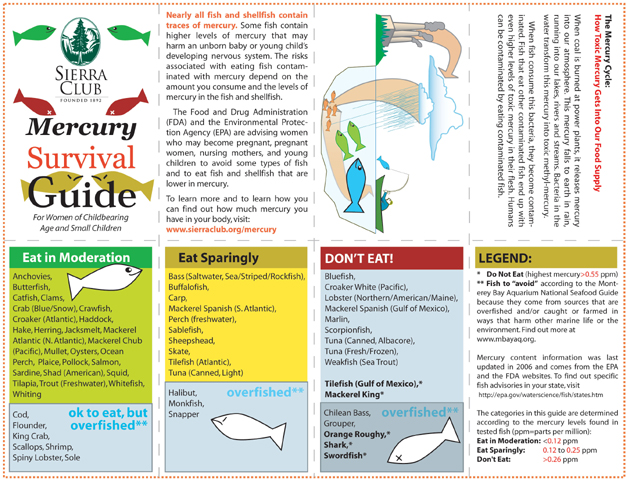
DID YOU KNOW?
When mercury from power plants settles on bodies of water, biochemical processes convert it into methylmercury, a form more readily taken up by living things. It bioaccumulates up the food chain, making many fish species hazardous to eat, especially for children and women of childbearing age.
All states except Wyoming and Alaska have issued fish-consumption advisories; you can find them at the EPA's website.
Easier still, you can clip and fold the pocket guide above, or download it at http://bit.ly/fishguide.
Coal Ash: Close the Poison Pits
If the nuclear industry were allowed to just shovel its radioactive waste into open pits, nuclear power would look like a bargain. One reason coal appears to be America's cheapest energy source is that the feds don't regulate coal ash and other waste products left behind when coal is burned in power plants. So the industry does shovel its waste into open pits, abandoned mines, and huge slurry ponds like the one that burst its banks last December in Kingston, Tennessee, sending a billion gallons of toxic goo into and across the Emory River, covering 300 acres six feet deep.
Burning coal to produce half of the nation's electricity and a third of its global-warming gases leaves behind some 131 million tons of ash per year. Ash piles up in the 584 dumps throughout the nation, poisoning streams, groundwater, wildlife, and humans.
How poisonous is it? Back in 1980, Congress told the EPA to find out. It took the agency until 2002 to come up with a "risk screening"--which it would not make public. Freedom of Information Act requests by the Sierra Club forced the agency to divulge some material, although key sections were blacked out. The full report was not released until this March. It revealed that if you drink well water contaminated by arsenic from coal ash, you have a 1 in 50 chance of contracting cancer--worse odds than if you smoke a pack of cigarettes a day.
And speaking of shoveling radioactive waste into open pits--that's exactly what coal-fired power plants do. Because of the trace amounts of uranium and thorium in coal, reports Scientific American, fly ash "carries into the surrounding environment 100 times more radiation than a nuclear power plant producing the same amount of energy."
WHAT YOU CAN DO
The EPA should regulate coal ash as hazardous waste. It will probably need to be stored in monitored, covered landfills with liners to prevent leaching into groundwater. Write to EPA administrator Lisa Jackson at
action.sierraclub.org/bigpicture_ash.
DID YOU KNOW?
You might want to find out what's stored in that ugly pond up the hill. Of the 584 coal ash dumps scattered across the country, the EPA judges 49 to be "high hazard," at risk for catastrophic failure. Another Freedom of Information Act request by the Sierra Club led the EPA to reveal their locations. (The agency had initially refused, because of unspecified "national security concerns.") These dangerous sites are found in 12 states, with the greatest numbers in North Carolina (12) and Arizona (9). Utility giant American Electric Power is responsible for 11 of the impoundments, followed closely by Duke Energy and Arizona Electric Power.
Thirty of the "high hazard" dumps are in impoverished areas. In Louisa, Kentucky, home to the Big Sandy coal ash site, nearly 33 percent of nearby residents live below the poverty level ($22,000 a year for a family of four).
Biofuels: Reverse Alt-Energy Insanity
WILD WORLD OF BIOFUELS
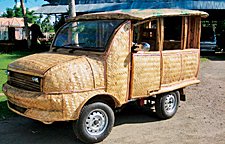
Coconut-powered taxi in the Philippines.
Thus far, commercial biofuels are made mostly from corn, vegetable oils, even leftover french fry grease. But they can be made out of nearly anything. Here are 10 novel sources of energy to top off your tank:
- COCONUTS The Philippine town of Tabontabon is served by two taxis 90 percent made of bamboo and powered by coconut oil.
- E. COLI Not just for hamburgers anymore.
- CHICKEN FEATHERS The 11 billion pounds of chicken feathers left over from the U.S. poultry industry each year could make 153 million gallons of biodiesel.
- SHARK CARCASSES Apparently there's an oversupply in Greenland.
- SEWAGE-FILLED BAGS NASA scientists think floating bags of algae could clean up sewage and also produce biofuel.
- CHOCOLATE Scientists in England have built a race car powered by waste from chocolate factories; it can go 145 mph.
- TUNG TREE NUTS China has three plants making fuel out of tung oil, normally a wood-finishing product. It may not happen here, where the tung tree is considered an invasive pest.
- PET POOP San Francisco, which has more dogs than children, is exploring the possibilities.
- TREE FUNGUS Patagonia's Gliocladium roseum can be turned into "myco-diesel."
- LIPOSUCTION FAT Yeah, sorry we mentioned it too.
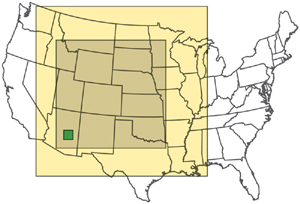
STILL A LOT OF ALGAE
If we grew all our fuels, there might not be room for much else. Show here is the amount of land it would take to replace half of U.S. petroleum-diesel usage with corn (shown in yellow), soybeans (tan), and algae (green).
Biofuels such as ethanol and biodiesel are popular with a lot of people for a lot of reasons. They replace the fossil fuels burned in cars and trucks that account for nearly a quarter of all U.S. carbon dioxide emissions. They reduce our dependence on foreign oil. And--not least--they promise vast new markets for U.S. agribusiness.
All of the above make them very attractive to Congress, which has enthusiastically embraced renewable fuels. In 2007, Congress mandated that domestic biofuel production rise each year, reaching 7.5 billion gallons in 2012. For most cars, this means ethanol, largely derived from corn. Diesel-powered vehicles can use biodiesel made from just about anything fatty (see "Wide World of Biofuels," right).
Sounds great, right? Only one problem: Biofuels from corn, palms, and other vegetation can make global warming worse. Princeton University researcher Tim Searchinger has shown that producing corn ethanol has twice the warming impact of gasoline. Even trendy substitutes like switchgrass can double emissions.
The reason: When biofuel crops displace food crops, people don't stop eating, so more forest or grassland is cleared for agriculture. (To the extent that it isn't, more people will starve--an even unhappier outcome.) And clearing new land releases huge amounts of carbon dioxide. "Every acre of land you use for biofuels," says Searchinger, "is land that isn't doing something else, and that something else could be storing carbon." So even if biofuels produce less CO2, pound for pound, than gasoline, it would take decades to make up for the initial deficit. (How many decades? Biofuel fans propose 100 years; the Sierra Club and other environmental groups insist that it should be no longer than 30.)
This May the EPA took an important step by proposing a rule that would require "lifecycle analysis" of biofuels' impacts, including changes in land use. If palm oil production requires razing rainforests in Borneo, for example, that would have to be accounted for. This "renewable fuel standard" would favor those with the smallest carbon footprint, with one enormous exception: The rule exempts corn ethanol produced by existing plants.
Biofuels may yet be part of the solution to global warming; one promising possibility is carbon-absorbing biodiesel derived from algae (see "Innovate," page 14). A minimum standard on a substitute for gasoline, however, should be that it doesn't exacerbate the climate crisis.
Illustrations, from top: Peter and Maria Hoey, Victor Juhasz (6).
Endangered species photos by iStockphoto. Left column, from top: P_Wei, jkklune, MtalStudios, Ogphoto, HenkBentlage, lightasafeather, NaluPhoto; right column, from top: rpbirdman, hbak, Byronsdad, JohnPitcher, flammulated, WinterWitch, John Pitcher
Mountaintop removal photo: Cameron Davidson; bamboo car photo: Tabontabon Organic Transport Industry